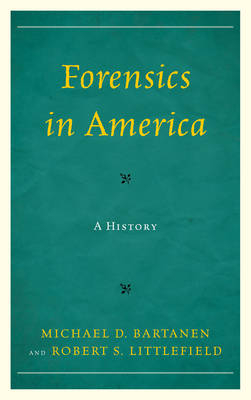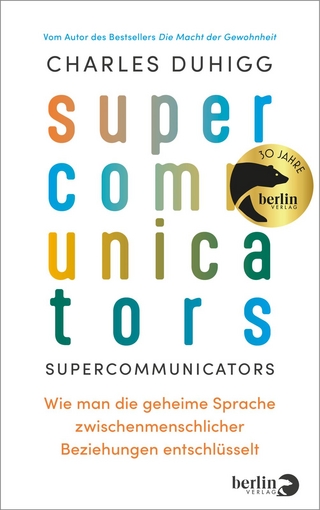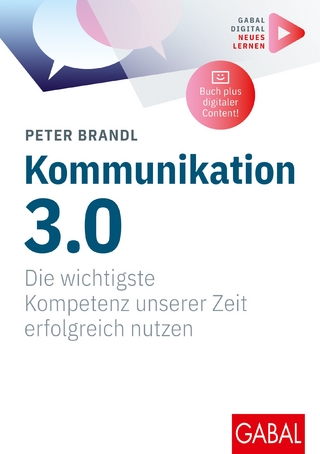
Forensics in America
Rowman & Littlefield (Verlag)
978-1-4422-2620-3 (ISBN)
This authoritative history shows how forensics, as practiced in the United States, was an uneasy fusion of contradictory premises that began as a significant part of the tradition of American public address: The need for preparing students to participate in democratic governance in conflict with a student’s need to express personal and competitive impulses. Forensics represented a push and pull between an activity simultaneously considered to be both a public and a private good.
The book:
·identifies the themes and trends of American forensics within an overarching chronological framework;
·reveals the impact of American forensics on the communication discipline, as well as America’s social and educational systems;
·concentrates on the elements of social history that contributed to organizational development, leadership, and politics; and,
· provides a base line reflecting the influences of both American culture in particular, and western culture in general, for cross-cultural comparisons between processes and effects of forensics as a form of education.
While intrinsically valuable as part of a comprehensive understanding of the history of higher education in the United States in the 20th Century, Forensics in America: A History is significant in providing a context for understanding the role forensics may play in the 21st Century. The book expands the study of American public address, focuses on the pedagogy of forensics training, and explores cultural dimensions of forensics activities.
Michael Bartanen is professor of communication and chair of the department of communication and theatre at Pacific Lutheran University. Bartanen has taught at Pacific Lutheran since 1979. He is the author or co-author of four previous books in forensics theory which were well-received by reviewers, and a number of journal articles and conference presentations. He has been active in forensics education and service in many forensics organizations, most recently, Pi Kappa Delta which is the largest collegiate forensics honorary society in the United States. Robert S. Littlefield is professor of communication at North Dakota State University. He is a life-long forensic educator, having taught at North Dakota State University since 1979. He is the author, co-author, or editor of three previous books, one of which focused on the history of forensics in North Dakota during the 20th Century. He has published over 75 journal articles (30+ on forensics-related topics, given nearly 100 conference presentations (50+ on forensics-related topics), and currently serves as Editor of Communication Studies, the journal of the Central States Communication Association published by Taylor & Francis.
Table of Contents
List of Tables
Preface
Acknowledgements
Chapter 1: An Introduction to the Study of American Forensics In the 20th Century
The Importance of Historical-Critical Research in Forensics
The Broad Outline of a Historical Study of American Forensics
The Focus of This Text and Assumptions Guiding Our Analysis
Forensics is Epistemic
Forensics is Rhetorical
Combining the Epistemic and Rhetorical
Assumptions and Themes of this Analysis
Theme One: The History of American Forensics
Theme Two: The Relationship between Collegiate and High School
Forensics
Theme Three: Forensics as a Promise and Consequence of American
Education
Theme Four: Forensics as a Resilient and Enduring Education Form
Theme Five: The Relationship between Forensics and the
Communication Discipline
The Plan of the Book
References
Part I: The Historical Context of Forensics Practice
Chapter 2: The Public Oratory Era
Forensics in the Pre-Competitive Era
Early Debating
The Literary Society
The Social and Historical Forces Shaping American Life and Education
A Brief Overview of the Public Oratory Era
The Progressive Era
Voluntary Associations for Civic Engagement
The Role of Education in Citizenship Training
The Influence of Higher Education on the Growth of Forensics
The Characteristics of the Public Oratory Era of Forensics
The Role of Students
The Prominence Afforded by Forensics Participation
Forensics and the Local Community
Audience-Centered Focus
The Emergence of Organizational Structures
The Nature of Forensics Practice in the Public Oratory Era
The Emergence of Forensics Models
The Consolidation of Forensics Practices
Conclusion
References
Chapter 3: The Technical Era
The Changing University: Science, Technology, and Government Intervention
Changes in the Student Body Makeup
Growth in Graduate Education
Government Involvement in Educational Policy
The Uneasy Relationship between Practicality and Intellectualism
Forensics Practice in the Two Periods of the Technical Era
Trends During the Technical Era
Competitive Emphasis Replaced the Educational Emphasis
Forensics as a Private Good Replacing Forensics as a Public Good
Invention and Style Dominate Competitive Forensics
Effects of the Shift to the Technical Era
Fractionalization of Shared Norms and Values
Marginalization within the Academic Community andthe
Communication Discipline
Conclusion
References
Chapter 4: Organizational Structures and their Influence on Forensics Practice
The Role of Honorary Societies in Organizing Forensics
The Importance of Social and Fraternal Organizations as an Organizing Model
Delta Sigma Rho
Tau Kappa Alpha
Pi Kappa Delta
Development of Regional Units
Introduction of the Tournament Format
A National Resolution for Debate
The Role of Honorary Organizations in Promoting Forensics Scholarship
An Overview of Scholarship about Forensics
Education versus Competition
The Influence of Organizational Philosophies
Philosophical versus Practical
Centrality to the Discipline
Shift from Community to Individual
Implications of Forensics Scholarhsip
An Analysis of Forensics Organizational Typology and Behavior
Transition from Introversion to Extroversion
Changes in Higher Education
The Effects of Competition
Organizational Turmoil during the Technical Era
Selection of the Recognition of Communist China Debate Topic
The Emergence of National Championships in Individual
Speaking
The Zero-Sum Competitive Environment
Significant Examples of Extroverted-Expansive Forensics
Organizations
The Rise of Specialization
The Emergence of New Debate Organizations
Conclusion
References
Part II: The Tensions Shaping the Evolution of Forensics
Chapter 5: Tensions that Shaped the Evolution of Forensics
The Population of the Forensics Community
The Inherency of Competition in Forensics
Debating Both Sides of the Resolution
Decision versus No-Decision Debating
Audience and Lay Judges versus Expert Critic Judging
The Introduction of the Tournament
The North Central Association Threat
Summary
Impacts and Implications of Competition
Student Interest
A Split in the Ranks
Forensics Scholarship
Competition Led to Specialization
Conclusion
References
Chapter 6: Departmental and Disciplinary Tensions Shaping Forensics
Academic Debate and the Emergence of Speech as a Discipline
The Foundations of the Speech Discipline
The Influence of Student Interest
Motivation for the Separation of Speech from English
Perceived inferiority
Public demand
Disciplinary marginalization
The Formation of the National Association of Teachers of Public
Speaking
The Marginalization of Forensics
Summary
The Discussion Movement’s Impact on Debate
Background on the Discussion Movement
The Trojan Horse of Citizenship Training
Debate vs. Discussion as Preparation for Civic Engagement
Supremacy versus Co-existence
Impact on Forensics
Summary
Conclusion
References
Chapter 7: High School Forensics: The Growth and Development of Competitive ForensicsThe Influence of Adult Education Movements on Forensics
Lyceums
Chautauqua Programming
The Extension Movement
Efforts to Serve Rural America
University Extension Efforts
The Emergence of Statewide Competitive Forensics Activities
Texas - A Representative Example
Triangulation
National Federation of High Schools Activities Associations
The National Forensic League
Brief Early History
Aims of the NFL
Features of the NFL
Democratic participation
Focus on the public
NFL’s Impact on High School Forensics
The Impetus for the National Catholic Forensic League
The Impacts of the National High School Leagues
The Impact of Collegiate Forensics
The National Federation of High School Activities Associations
Additional Quasi-Competitive Opportunities
Conclusion
References
Part III: Socio-Cultural Dimensions Contributing to the Evolution of Forensics
Chapter 8: The Social Dimensions of Forensics
The Justificatory Overemphasis on Intellectual Benefits of Forensics Training
Forensics as Play
Play is Self-Chosen and Self-Directed
Play is Activity where Means are More Valued than Ends
Play has Rules not Dictated by Necessity
but Emanating from the Participants
Play is Imaginative, Non-literal, and Mentally Removed from
“Real” Life
Play involves an Active, Alert, but Non-stressed Frame of Mind
Three Dimensions of Forensics as Play
Simulation
Socialization
Community and Conversation
Creation of Social Capital During the Public Oratory Era
The Role of Students
A Position of Celebrity
An Emphasis on Local Prominence
A Focus on the Audience
Creation of Social Capital During the Technical Era
The Fun of Critical Thinking
Toulmin’s Model
The Changing Nature of Forensics as Fun
The Downside of Forensics as Play
Conclusion
References
Chapter 9: “The Other” in Forensics: The African American Experience
The Exclusion of African Americans
The African American Educational Experience
The African American Forensic Experience
Literary Societies
Intercollegiate Debate
Forensics in the Public Oratory Era
Characteristics of forensics at non-HBCUs
Characteristics of forensics at HBCUs
Summary
Forensics in the Scientific/Technical Era
Characteristics of forensics at non-HBCUs
Characteristics of forensics at HBCUs
Urban Debate Leagues
The Activity Kritik
Summary
Reflections on Forensics and the Other
Conclusion
References
Chapter 10: The “Other” Sex: Women and the Forensics Experience
Women and the Forensic Community
Context for the Education of Women
Exclusion of Girls and Women
Limited Educational Opportunities
Segregated colleges developed to Teach Women
General Treatment of Women in Higher Education
Brief Chronology of Women’s Entry into Forensics
Barriers for Women in Forensics
Separate contests for Wen and Women
The Value of Women in Forensics was Misplaced
The Perceived Limited Capacity of Women
Illegitimacy of Women as High-level Competitors
The Perceived Sexual Vulnerability of Women
Perceived Role for Women in policymaking orLeadership Positions
Conclusion
References
Chapter 11: Reflections on a Century of Forensics in America
The Social Construction of Forensics
Critical Stance Toward Existing Order
Influence of History and Culture
The Act of Communication
The Mix of Knowledge and Social Interaction
A Post-Modern Era?
Multiple Frameworks
A Decline in the Number of Career Professionals
Impact of New Technologies
Summary
The Epistemic Nature of Forensics
References
| Erscheint lt. Verlag | 7.1.2014 |
|---|---|
| Verlagsort | Lanham, MD |
| Sprache | englisch |
| Maße | 159 x 236 mm |
| Gewicht | 626 g |
| Themenwelt | Sachbuch/Ratgeber ► Beruf / Finanzen / Recht / Wirtschaft ► Briefe / Präsentation / Rhetorik |
| Recht / Steuern ► Strafrecht ► Kriminologie | |
| ISBN-10 | 1-4422-2620-X / 144222620X |
| ISBN-13 | 978-1-4422-2620-3 / 9781442226203 |
| Zustand | Neuware |
| Haben Sie eine Frage zum Produkt? |
aus dem Bereich


